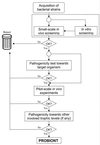Probiotic bacteria as biological control agents in aquaculture
- PMID: 11104813
- PMCID: PMC99008
- DOI: 10.1128/MMBR.64.4.655-671.2000
Probiotic bacteria as biological control agents in aquaculture
Abstract
There is an urgent need in aquaculture to develop microbial control strategies, since disease outbreaks are recognized as important constraints to aquaculture production and trade and since the development of antibiotic resistance has become a matter of growing concern. One of the alternatives to antimicrobials in disease control could be the use of probiotic bacteria as microbial control agents. This review describes the state of the art of probiotic research in the culture of fish, crustaceans, mollusks, and live food, with an evaluation of the results obtained so far. A new definition of probiotics, also applicable to aquatic environments, is proposed, and a detailed description is given of their possible modes of action, i.e., production of compounds that are inhibitory toward pathogens, competition with harmful microorganisms for nutrients and energy, competition with deleterious species for adhesion sites, enhancement of the immune response of the animal, improvement of water quality, and interaction with phytoplankton. A rationale is proposed for the multistep and multidisciplinary process required for the development of effective and safe probiotics for commercial application in aquaculture. Finally, directions for further research are discussed.
Figures
Similar articles
-
The role of probiotics in aquaculture.Vet Microbiol. 2006 May 31;114(3-4):173-86. doi: 10.1016/j.vetmic.2006.01.009. Epub 2006 Feb 21. Vet Microbiol. 2006. PMID: 16490324 Review.
-
A review on the application of Bacillus as probiotics in aquaculture.Fish Shellfish Immunol. 2019 Apr;87:820-828. doi: 10.1016/j.fsi.2019.02.010. Epub 2019 Feb 16. Fish Shellfish Immunol. 2019. PMID: 30779995 Review.
-
The use of probiotics in shrimp aquaculture.FEMS Immunol Med Microbiol. 2006 Nov;48(2):149-58. doi: 10.1111/j.1574-695X.2006.00116.x. FEMS Immunol Med Microbiol. 2006. PMID: 17064272 Review.
-
The use of probiotics in aquaculture.J Appl Microbiol. 2015 Oct;119(4):917-35. doi: 10.1111/jam.12886. Epub 2015 Aug 2. J Appl Microbiol. 2015. PMID: 26119489 Review.
-
The functionality of probiotics in aquaculture: An overview.Fish Shellfish Immunol. 2021 Oct;117:36-52. doi: 10.1016/j.fsi.2021.07.007. Epub 2021 Jul 15. Fish Shellfish Immunol. 2021. PMID: 34274422 Review.
Cited by
-
Dietary supplementation of two indigenous Bacillus spp on the intestinal morphology, intestinal immune barrier and intestinal microbial diversity of Rhynchocypris lagowskii.Fish Physiol Biochem. 2022 Oct;48(5):1315-1332. doi: 10.1007/s10695-022-01121-0. Epub 2022 Sep 14. Fish Physiol Biochem. 2022. PMID: 36103020
-
Probiotic Potential of Autochthonous Bacteria Isolated from the Gastrointestinal Tract of Four Freshwater Teleosts.Probiotics Antimicrob Proteins. 2017 Mar;9(1):12-21. doi: 10.1007/s12602-016-9228-8. Probiotics Antimicrob Proteins. 2017. PMID: 27557836
-
In vitro Assessment of the Safety and Potential Probiotic Characteristics of Three Bacillus Strains Isolated From the Intestine of Hybrid Grouper (Epinephelus fuscoguttatus♀ × Epinephelus lanceolatus♂).Front Vet Sci. 2021 May 28;8:675962. doi: 10.3389/fvets.2021.675962. eCollection 2021. Front Vet Sci. 2021. PMID: 34124228 Free PMC article.
-
Comparative Study of the Gut Microbiota Community between the Farmed and Wild Mastacembelus armatus (Zig-Zag Eel).Metabolites. 2022 Nov 29;12(12):1193. doi: 10.3390/metabo12121193. Metabolites. 2022. PMID: 36557231 Free PMC article.
-
Isolation and characterization of native probiotics for fish farming.BMC Microbiol. 2018 Sep 20;18(1):119. doi: 10.1186/s12866-018-1260-2. BMC Microbiol. 2018. PMID: 30236057 Free PMC article.
References
-
- Atlas R M, Bartha R. Microbial ecology—fundamentals and applications. Menlo Park, Calif: Benjamin/Cummings Science Publishing; 1997.
-
- Austin B, Baudet E, Stobie M. Inhibition of bacterial fish pathogens by Tetraselmis suecica. J Fish Dis. 1992;15:55–61.
-
- Austin B, Billaud A C. Inhibition of the fish pathogen, Serratia liquefaciens, by an antibiotic-producing isolate of Planococcus recovered from seawater. J Fish Dis. 1990;13:553–556.
-
- Austin B, Day J G. Inhibition of prawn pathogenic Vibrio sp. by a commercial spray-dried preparation of Tetraselmis suecica. Aquaculture. 1990;90:389–392.
-
- Austin B, Stuckey L F, Robertson P A W, Effendi I, Griffith D R W. A probiotic strain of Vibrio alginolyticus effective in reducing diseases caused by Aeromonas salmonicida, Vibrio anguillarum and Vibrio ordalii. J Fish Dis. 1995;18:93–96.
Publication types
MeSH terms
LinkOut - more resources
Full Text Sources
Other Literature Sources


